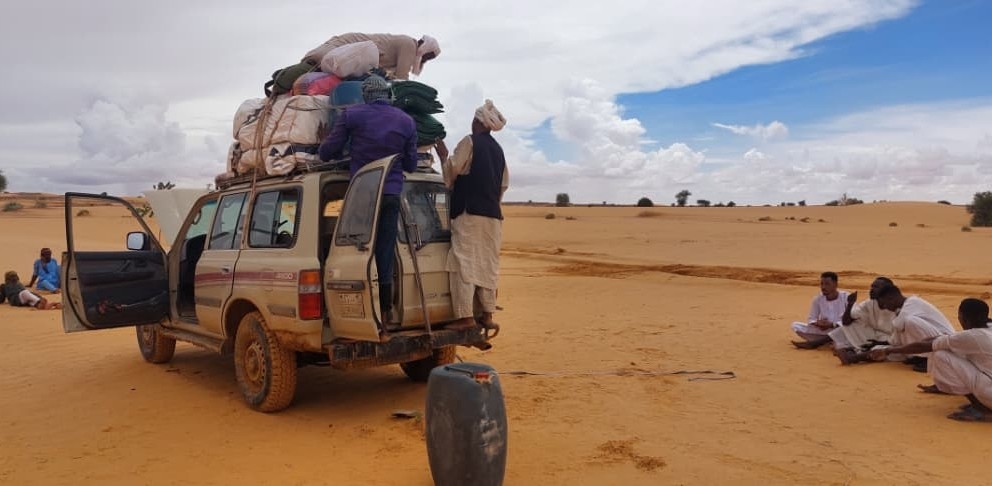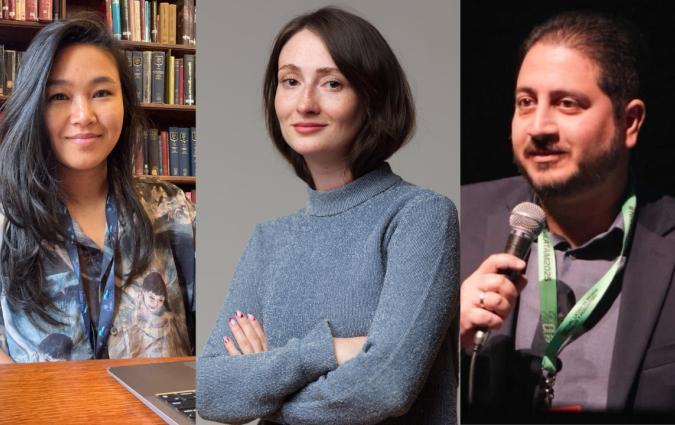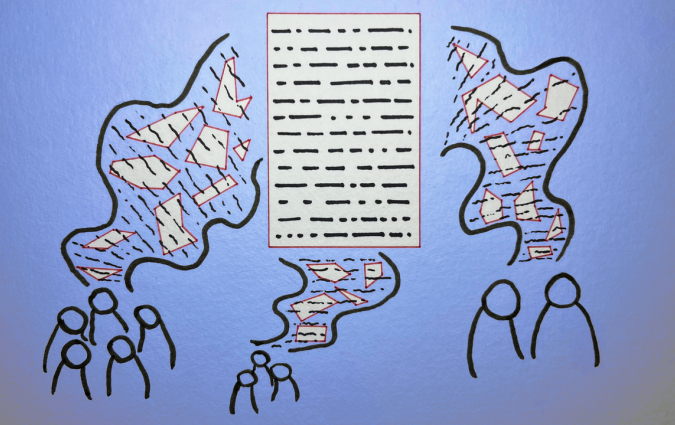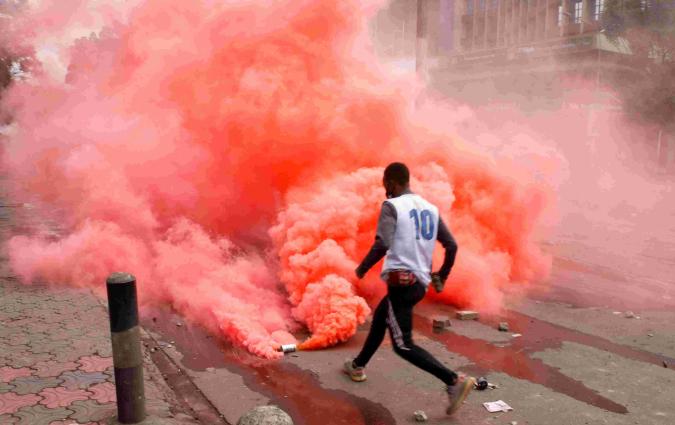How this newsroom braves Sudan’s civil war to keep the world informed

Image credit: Basma Shams.
When war broke out in Sudan in April 2023, Basma Shams witnessed independent journalism collapse under the weight of violence and repression.
A brutal information war between the Sudanese Armed Forces and the paramilitary Rapid Support Forces (RSF) soon drowned out ordinary voices. For millions of Sudanese, the truth about atrocities, displacement, and daily survival became as scarce as food, water, and electricity.
“All the news was from the RSF or the military. There was no independent journalism,” said Shams, an engineer in the city of El-Obeid.
From inside the besieged city, Shams began posting on Facebook, sharing news of daily hardships and bombings for relatives and fellow Sudanese abroad. Three months after the war began, a Facebook friend connected her with the Ayin Network, a clandestine collective of Sudanese journalists working under pseudonyms. They told her she could be a valuable correspondent, someone who could show the outside world what was happening in El-Obeid.
“I had never been a journalist before,” Shams said. “But I thought, why not? It was a chance to spotlight what was happening in my city.”
I spoke with Shams, fellow Ayin reporter Eiad Husham and the network’s managing editor, Tom Rhodes, to find out how grassroots journalism persists in one of the most dangerous countries for reporters.
In the two and a half years since the war broke out, over 150,000 civilians are thought to have died. However, measuring casualties is difficult due to the chaos in the country and the fact that the warring parties are blocking access to researchers and humanitarian relief workers. The former US special envoy for Sudan believes the death toll exceeds 400,000.
Bridging the information divide
Founded in 2013, the Ayin Network set out to break Sudan’s media repression by amplifying voices outside Khartoum.
“Our mission has always been to bridge the gap between the capital and the rest of the country,” said managing editor Tom Rhodes.
Shams is exactly the kind of reporter the Ayin Network was built to support. She had written a few reports about the war on her own, but never with video or photography. The Ayin Network trained her remotely, and by late July 2023, she was filing stories regularly while maintaining her cover as an engineer.
“We started with mobile phones and citizen videos,” said Rhodes. “If you pull out a big camera, it’ll immediately create a reaction, draw attention to you, whereas the phone was a much safer, quicker way to do this coverage.”
Using her phone, Shams documented the horrors of war, from a school day shattered by a bombing to the desperate struggles of kidney patients amid a paralysed health system. But her focus remained fixed on people’s daily battle for survival, reporting extensively on the soaring prices, crippling water crisis, and exhausting power outages that defined life for those trapped inside.
Shams also captured the resilience of her community, including the women and students running a war-relief bazaar, the collective effort to shelter displaced families in schools, and the defiant determination of students sitting for exams amidst the conflict.
Reporting under siege
International journalists have been largely shut out of Sudan, and most local media have been shuttered or co-opted by the warring factions.
Working as a journalist in Sudan is extraordinarily dangerous. The Committee to Protect Journalists (CPJ) has documented killings, beatings, detentions, and interrogations, with at least 11 journalists killed in connection with the ongoing conflict. Sudan ranks 156th out of 180 countries on the World Press Freedom Index.
Sara Qudah, CPJ’s Middle East and North Africa regional director, said reporters face hunger, violence, and sexual assault, yet many “persist in trying to report.” She added that the threats go beyond physical danger as journalists also endure medical neglect, psychological trauma, and censorship, a combination that reflects “a systematic effort to silence voices.”
“This is not only a humanitarian crisis, but also a crisis for transparency, accountability, and rights,” Qudah emphasised.
Defiance in the face of danger
Eiad Husham, a Sudanese investigative journalist in exile, decided from the outset that he would report under his real name and publish his work openly, including on social media.
“I have the right to report,” he said, insisting he would not be intimidated into anonymity.
He uncovered seven detention centres where Sudanese asylum seekers were held in inhumane conditions. He revealed how Israel blocked any future role for Islamists in Sudan and how the UAE pressured Saudi Arabia and Egypt to comply, while analysing the complex dynamics behind U.S.-brokered peace initiatives. He also documented the deadly capabilities of RSF drone strikes in El Fasher and followed individual stories of suffering, such as that of Khalid Esti, a young protester who endured starvation in detention.
When one investigation proved particularly dangerous, Husham considered removing his byline for safety, but defiance won out: “I said no, they’re not going to scare me. We have to do our work. They may not like it, but it’s our duty to tell the truth.”
The daily struggle to report
For reporters like Shams working inside the country, the challenges are immense. El-Obeid had almost no electricity during the siege, which lasted about 22 months. Sometimes they would get power for one or two days, then lose it for months.
Sometimes the government cut internet access for “security reasons”. Sometimes, Shams spent an entire day trying to send short video files. Some stories took her over a week to send. “Uploading a five-minute video could take two to five hours,” she said. When El-Obeid had no internet at all, Shams had to leave the city just to send her reports. She moved more than three times, and once travelled nearly 700 kilometres to El-Gadarif, where electricity and internet were still available.
The dangers multiplied at roadside checkpoints. Some were manned by local armed groups, others by boys barely into their teens. “At one checkpoint, I saw a boy holding an RPG [a shoulder-fired anti-tank weapon] who was the same height as the weapon itself,” she said. When their driver tried to speed past, one of the boys fired at the car.
“It was terrifying,” she said. “I thought we would die.” No one was hurt, but the driver didn’t try that again at the checkpoints ahead.
Working without phone service or internet meant Shams had to find sources in person, knocking on doors, meeting them at workplaces or homes. Security services, military, and intelligence agents were active everywhere, and anyone attempting independent journalism risked being arrested without charge.
“I always kept a low profile,” Shams said. “I trusted my sources carefully.”
The ‘Forty-Day Road’
In August 2024, Shams published an account of what Sudanese call Darb al-Arbaeen, or the ‘Forty-Day Road,’ a desert track that became the only lifeline between Sudan’s west and north after the RSF seized control of paved highways.
Her own journey home along that road was supposed to last two days. Instead, it stretched nearly a week. Torrential rains flooded the desert valleys, leaving convoys of trucks stuck axle-deep in mud. Stranded passengers slept outside, surrounded by snakes and scorpions, hunger gnawing as their food and water ran out.
Shams remembers clutching her work phone, terrified it might be discovered in a search. “I had to hide it the whole way,” she said. Sometimes she slipped it out quickly to take photos.

She was travelling alone, which was also dangerous. “The RSF often kidnapped women,” she said, “but I had no choice.” When it was too dangerous to write or record, Shams memorised details, storing names, prices, and scenes in her head until she reached safety.
“Sometimes I asked myself why I was risking this,” she said. “But I felt it was my responsibility. People needed to know what we were living through.”
To keep reporters safe, the Ayin Network relies on risk assessments and code words, a small emergency relocation fund, and constant check-ins. Even so, self-censorship has become necessary in places like Darfur, where filing a story often means walking into an internet café full of informers.
Not so safe even in exile
Even in exile, Husham’s safety was not guaranteed. While in the UAE, he investigated Colombian mercenaries linked to an Emirati company operating in Sudan. Hours before a scheduled interview, his source abruptly withdrew after a mysterious phone call. Soon, Husham noticed signs of surveillance, including strange clicks and echoes on his phone, blocked bank transactions, and similar disruptions on his wife’s phone.
“I felt like there were eyes on everything I did,” he said. Warned that Sudanese journalists had been detained in the UAE, he relocated to Nairobi. The investigation was left unfinished.
Rhodes said the Ayin Network tries to support its reporters with counselling and regular check-ins, but acknowledged the resources are limited. “We don’t do enough,” he admitted. At times, the strain also overwhelms editors, who sift through graphic footage daily.
“I hope I don’t collapse before this war ends,” Husham said. His family’s history of political repression, with a grandfather repeatedly detained and an aunt jailed during the revolution, helped shape his resilience. Separated from his father, who evacuated to Egypt while he fled to the UAE, Husham leaned on his wife and relatives for support. But his deeper strength came from the conviction that journalism itself was a form of resistance.
“If we stop reporting, we are failing our people,” he said. “The world already doesn’t care about us, and stopping would only make it worse. There will be plenty of time for us to take a vacation and focus on our mental health,” he said. “For now, we need to keep going.”
Rhodes said that this psychological strain is also why the Ayin Network insists on caution in the field. From the outset of the war, he and his team told reporters not to take unnecessary risks. “We can try to get you out if you’re detained, maybe help you relocate if things get too dangerous,” he explained. “But there’s only so much we can do. Your safety has to come first.” Even so, he acknowledged the tension, noting that sometimes freelancers send in footage that could only have been gathered at great risk. But they discourage such practices. “Generally, we focus less on frontline footage and more on the aftermath, because the story is never worth a life.”
On Facebook, Sudan’s dominant platform, the Ayin Network’s content is routinely targeted with coordinated complaints designed to trigger takedowns. “Different groups overload the reports to Meta to make sure pieces go down or get blocked,” Rhodes explained. “It happens all the time.”
Self-censorship has also become unavoidable. Rhodes noted that no one on their team has been directly targeted during the conflict, largely because they’ve had to hold back. In Darfur, for instance, a reporter who once filed exclusive stories weekly now manages only one a month, as publishing requires trips to internet cafés watched by RSF informers and soldiers. “Just sending a story can put him at risk,” Rhodes said. Some stories never make it out at all.
Keeping the network afloat
For the Ayin Network, financial survival has been as precarious as its reporters’ safety. Sustaining the operation, Rhodes said, is “a constant struggle.” The pressure, he added, often leaves him awake at night.
The challenge grew steeper after USAID abruptly cut its support, wiping out 75% of the Ayin Network’s funding. In the cuts, the group also lost trusted relationships that had helped sustain their work. The Ayin Network has since adopted a hybrid funding approach, both to maintain independence and to spend less time “appeasing donors and filling out extraneous grant reports.”
That approach means combining donor funding with commissioned work. About 20% of the team’s time now goes to producing documentaries, investigations, and footage for clients.
With the New York Times and the Centre for Information Resilience, Ayin helped uncover RSF abuses using open-source visual evidence. In partnership with The New Humanitarian, the team worked on a feature on Sudan’s mutual aid networks. The network has also contributed to independent film projects, including Khartoum.
A story the world needs to know about
Journalism in Sudan has always carried a price. For reporters like Husham and Shams, the toll was so high that both were forced to relocate, Husham to the UAE, then Kenya, and Shams to the United States.
For Shams, the displacement has been especially jarring. “For me, America is more difficult than wartime Sudan in some ways,” she said. “But I am starting again, and I’ll try to make it work.” Even in exile, she continues to support the Ayin Network whenever she can, passing along sources and helping with stories from afar.
While international partnerships have helped the Ayin Network’s work reach wider audiences, they also highlight the gap between local and foreign coverage of Sudan’s war.
Husham said much of international reporting reduces the conflict to a simplistic power struggle, overlooking both the regional dynamics and the human toll. For him, the war is not simply a contest between two armed groups but a catastrophe that has fractured communities, displaced millions, and reshaped the country’s social fabric.
He acknowledged the efforts of foreign correspondents in bringing attention to Sudan’s crisis and said he understood the challenges they face. Many, he noted, have relied on Sudanese journalists for context and connections on the ground. “We can connect the dots and bring the true voices of the Sudanese people,” he said.
Yet he worries those voices are being drowned out as the world’s attention shifts elsewhere. “Sudan is being forgotten,” he said. For Shams, Husham and their colleagues at the Ayin Network, that danger is exactly why they keep reporting: because if they fall silent, no one will tell their country’s story.
In every email we send you'll find original reporting, evidence-based insights, online seminars and readings curated from 100s of sources - all in 5 minutes.
- Twice a week
- More than 20,000 people receive it
- Unsubscribe any time







